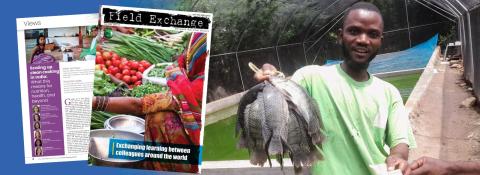Experiences implementing a rapid nutrition determinants assessment in Nepal
Lenka Blanarova Senior Nutrition Assessment Coordinator at Action Against Hunger
Erin McCloskey-Rebelo Independent Consultant and Moderate Wasting Initiative (MWI) Lead
Martha Nakakande Global Nutrition Cluster (GNC) Community Management of Acute Malnutrition Advisor at International Medical Corps, MWI
Andi Kendle GNC Operations Team Coordinator – Programmes at Action Against Hunger Canada
Manu Adhikari Senior Programme Officer at MWI, Action Against Hunger Nepal
What we know: An understanding of nutritional determinants and causal pathways is critical for designing contextualised and targeted programmes that address undernutrition in all its forms. Current assessment approaches are useful but may be time and resource intensive.
What this adds: As part of its broader work to support innovative solutions to respond to moderate wasting in children under five, the MWI, in partnership with Action Against Hunger, piloted a rapid nutrition determinants assessment (NDA) approach in Nepal. This article describes the development of this qualitative approach and challenges, opportunities, and lessons learned through the experience.
Background
Most NDAs, also called nutrition causal analysis assessments (NCAs), seek to understand the multi-sectoral nature of nutrition determinants within a given area, to inform contextualised programmatic responses. In recent years, the Link NCA method – spearheaded by Action Against Hunger – has been a popular method for assessing nutrition determinants through a participative, mixed-method approach. A key strength of Link NCA has been its ability to not only show relationships between various factors but also to describe how determinants are related to each other and the relative importance of each to the risk of developing undernutrition. Although fruitful, this approach has proven to be time and resource intensive, reducing its accessibility, especially in emergency and/or underfunded contexts.
The Nutrition Determinants Working Group (NDWG), a sub-working group of the GNC’s Nutrition Information Systems Global Thematic Working Group (GNC, 2024), discussed the need to develop a simple and affordable toolkit to help identify – and explain the relationship between – context-specific determinants, while promoting community engagement. The ultimate goal would be to encourage a more efficient and effective use of nutrition determinants data by programme implementers. This article describes the experiences of the GNC’s MWI, in partnership with the NDWG and Action Against Hunger, with funding from Irish Aid, in developing and testing a rapid qualitative NDA in Nepal.
The MWI aims to contribute to addressing the challenges that nutrition stakeholders have in developing, accessing, and utilising feasible, effective, and innovative solutions to respond to moderate wasting in children under five years old at scale. It seeks to support the development of programmatic solutions through a range of contextualised options, including the current standard of traditional nutritional supplementation with the provision of specialised nutritious foods. The MWI aims to use the outputs of the Nepal experience to feed into a larger pilot that supports countries to diversify and better contextualise approaches for the management of moderate wasting.
Rapid NDA
The Rapid NDA methodology was developed by Action Against Hunger and further contextualised in situ by the Action Against Hunger Nepal and MWI teams. The methodology aimed to fill specific information gaps, be quick to implement, be accomplished by a small team, and include a community validation exercise. Considering these specific needs, a qualitative approach was considered most appropriate.
The specific objectives of the assessment were to identify key determinants of undernutrition among the study population and to understand how determinants of wasting interact with each other, so as to determine which causal pathways are likely to explain most cases of wasting. The MWI in Nepal was specifically interested in moderate wasting. However, as communities could not differentiate causes of wasting and stunting, or the associated severity, the respondents were not asked to limit their responses to moderate wasting. Therefore, general undernutrition was considered in this setting.
Table 1: Rapid NDA and Link NCA comparison table
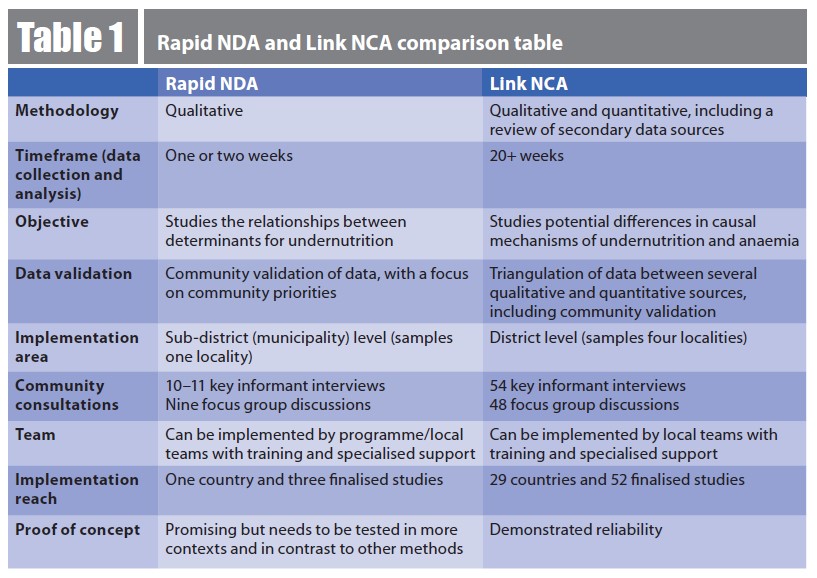
Sampling and data collection
Three pilot locations were selected in collaboration with Nepal’s Nutrition Technical Committee and the Integrated Management of Acute Malnutrition Working Group. Locations were selected to represent the three different geographical areas of Nepal – the mountains, the hills, and the ‘terai’ (lowlands) – to compare nutritional determinants in these areas. This would provide a contextualised analysis for the design of locally resourced solutions to improve the relevance and efficiency of moderate wasting programming in these locations.
The assessment was designed to be quick and easy to implement. Therefore, the number of community consultations was reduced from that required by a Link NCA (table 1) while trying to maintain the scope of thematic areas covered for it to remain relevant for the multi-sectoral analysis of nutrition determinants. The Action Against Hunger research team was comprised of one supervisor and two research assistants. The team was further supported by a community mobiliser, with technical support provided by the MWI/Action Against Hunger team both in country and remotely. The team spent a maximum of six days in each location, which included three and a half days for data collection, one day for data synthesis and analysis, and one day for community validation (table 2). Government stakeholders were involved in the assessment preparation and as respondents during data collection.
Table 2: Data collection and validation days per municipality
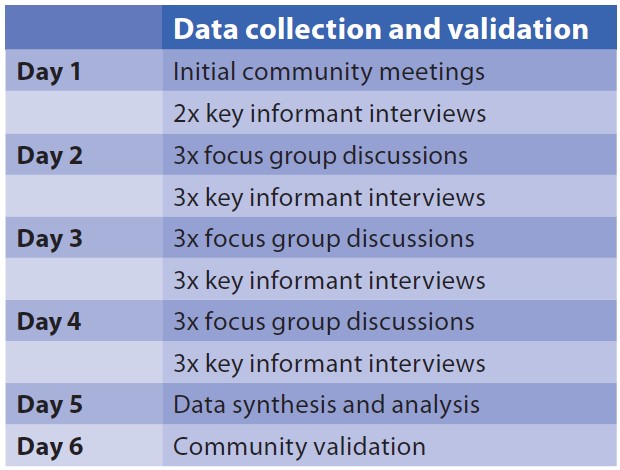
In each location, the research team conducted 10 or 11 semi-structured interviews and nine focus group discussions. Focus group discussions were with community leaders, traditional healers, health staff, representatives of local organisations, and the carers of children aged under five years.
Assessment tools
Interview guides covering the main determinant categories of undernutrition were developed for the semi-structured interviews and focus group discussions. These categories were: health and nutrition, mental health and care practices, food security and livelihoods, WASH, and gender. The interview guides were organised by sector but included questions for each determinant within that sector. Therefore, the team had the flexibility to ask questions according to feedback from the community. A variety of visual aids were used with the objective of assisting respondents to consider various determinants of undernutrition in the study area and to categorise them in terms of importance. Seasonal and historical calendars were used to identify temporal variations in determinants and their effect on child outcomes (figure 1).
Figure 1: An example of a seasonal calendar from Badimalika municipality, Nepal
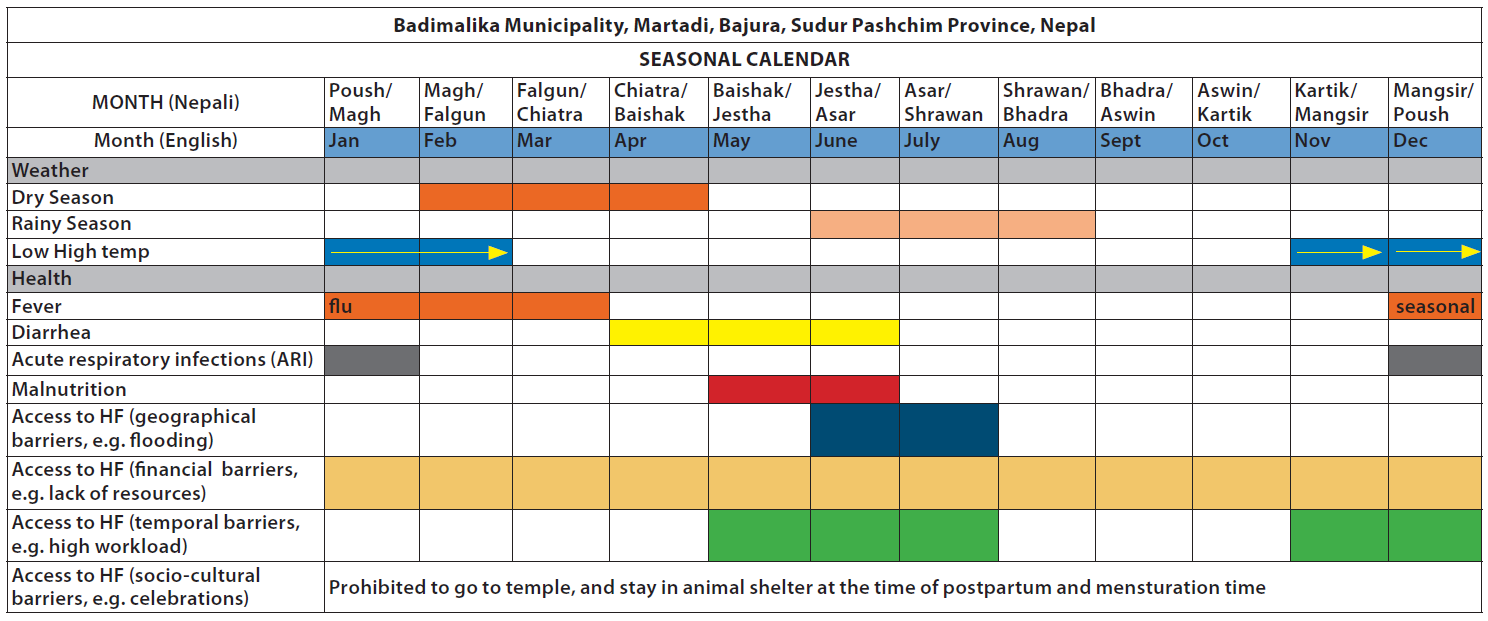
The community validation exercise remains a critical part of the data collection process and is intended to provide an additional level of sense-checking of the information emerging. For this process, active participants from the focus group discussions and key informant interviews are asked to come together and prioritise major and important determinants first through choosing individually (three stones for major and one stone for important) and then through group consensus. The outcome is intended to elucidate a more in-depth understanding of the community’s experience of the determinants and the various pathways.
Data analysis
Qualitative data was recorded manually in a notebook and reproduced electronically at the end of each data collection period in a sampled location, usually at the end of each day. The data was compiled in an Excel spreadsheet organised according to the five determinant categories to allow for an efficient analysis. Synthesis sheets (figure 2) allowed all determinants to be tracked to see the frequency with which they were raised throughout the sessions. All views were analysed using qualitative content analysis methods, whereby raw data was condensed into categories or themes and coded based on valid inference and interpretation.
For each location, the teams developed pathways based on how the community explained their experiences of the key nutrition determinants. These pathways were then confirmed with the community during the validation process.
Figure 2: Example of analysis framework
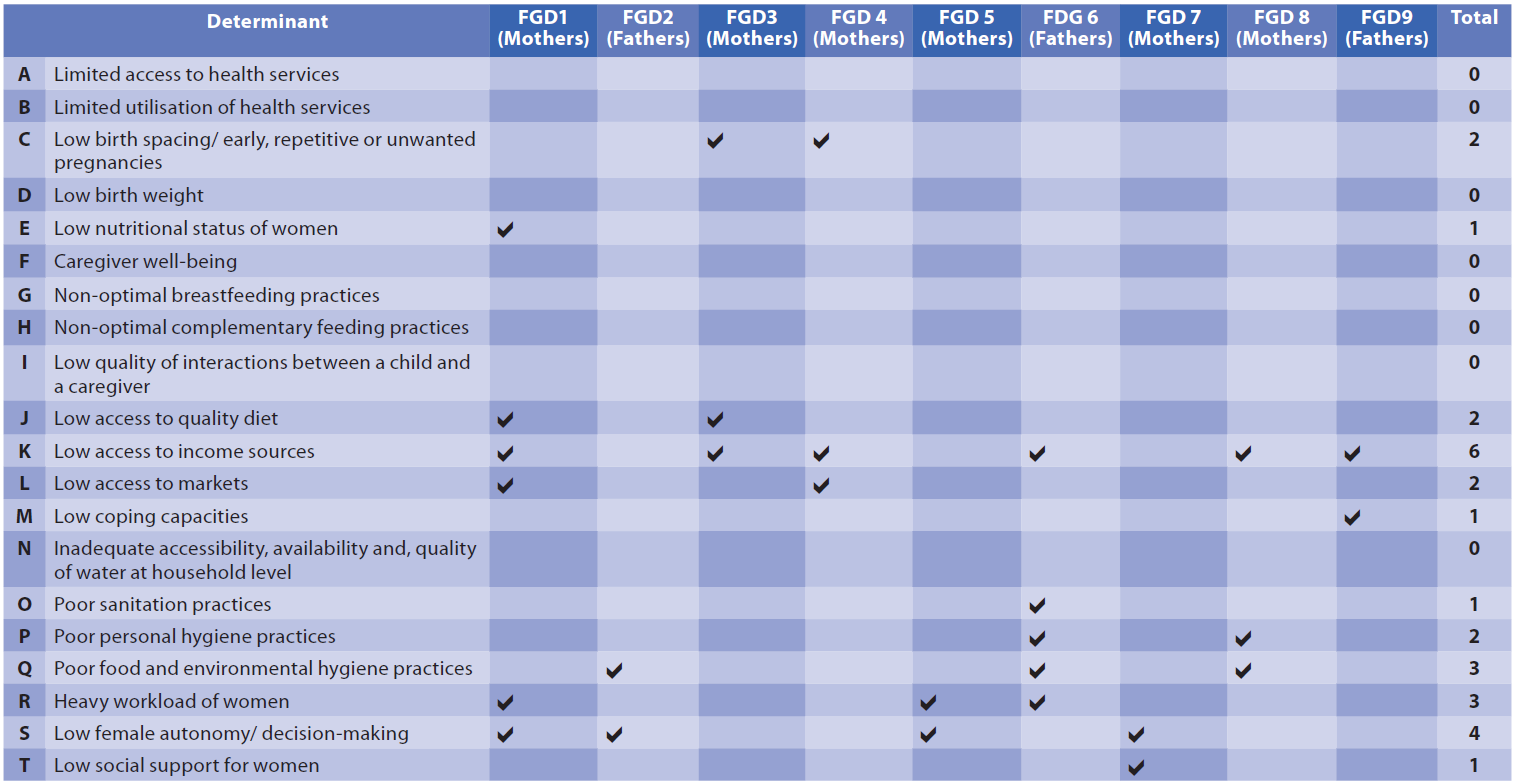
General findings
The findings produced from the Rapid NDA include a weighted matrix of nutrition determinants and a series of pathways describing how the community experiences those determinants through to illness and/or wasting. The assessment produced municipality-specific determinants and pathways. However, the scope of this article does not cover these details. Instead, it presents generalised findings to provide an example of the type of information produced.
Women’s workload and quality of diet were consistently ranked among the priority determinants of undernutrition in all three municipalities. Across the five determinant categories, the communities perceived gender to have the strongest influence on undernutrition, followed by food security/livelihoods, and WASH. Health and nutrition came next, followed by mental health and care practices. The dominance of gender across the three municipalities is an interesting finding and shows its critical importance to the community and their perceptions of how it influences child nutrition outcomes. Unfortunately, gender issues such as female time poverty are often complex cultural issues with limited programming designed to address them.
The importance of the determinants to undernutrition are weighted twice: once through the focus group discussions and key informant interviews, and then again through the community validation. This two-stage process is important for providing a full picture of how the determinants are related to each other and to child nutrition outcomes. Figure 3 shows an example findings framework from Sunil Smriti Rural Municipality, Rolpa district. Here, while focus group discussions and key informant interview respondents rated low access to quality diet within the fourth level of importance for undernutrition, the community validation process rated it as top priority. Even when sufficient income is available for food purchases, nutritious foods are not always available in the local market and/or not prioritised for purchase. This clarifies the importance of this determinant when seeking to address the local wasting burden.
Figure 3: Summary of nutrition determinants and their ranking for Rolpa district
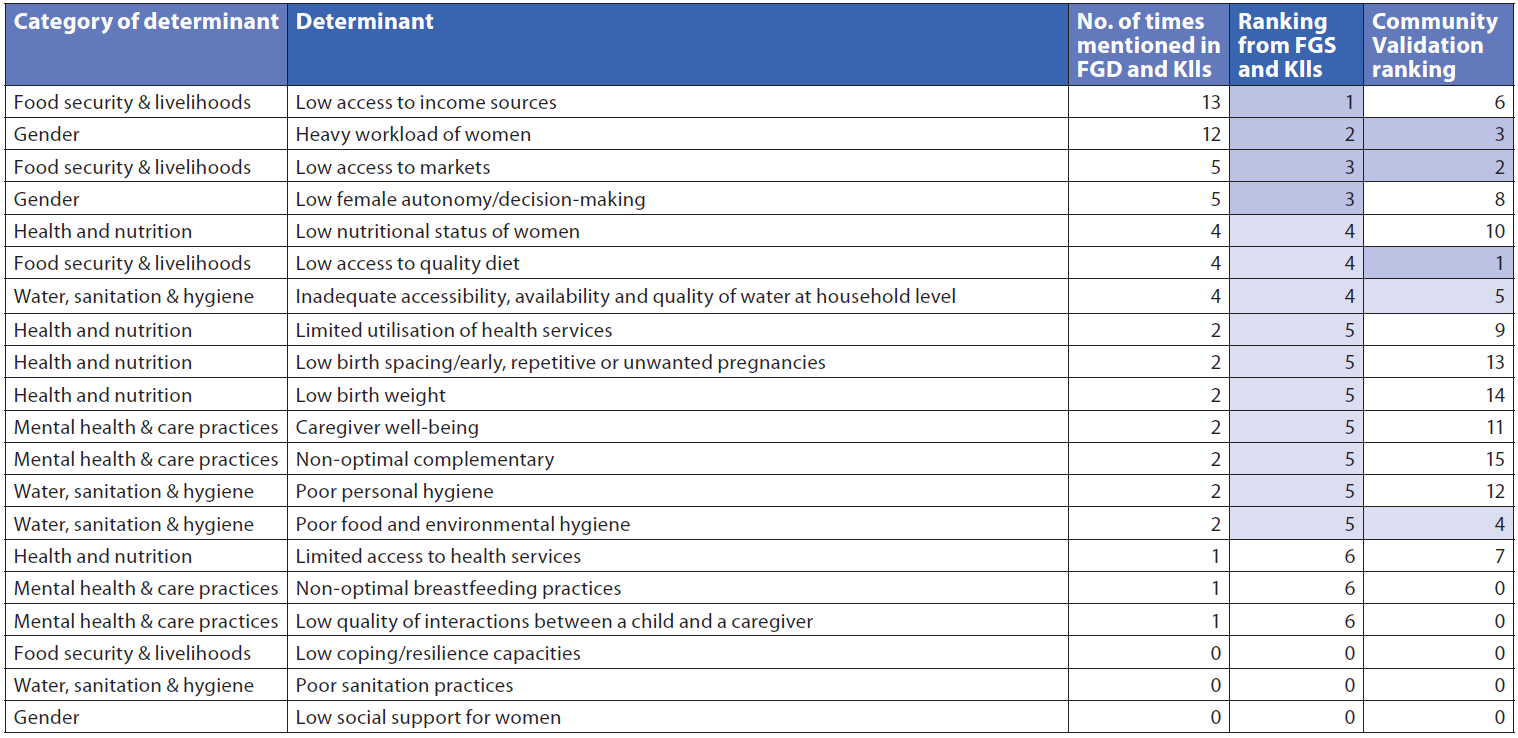
Challenges, opportunities, and learnings
Logistical and linguistic challenges
The standard challenges with implementing an assessment in a country like Nepal applied, particularly with respect to the geographical terrain and difficulties in accessing certain areas. In addition, Nepal’s linguistic diversity meant that composition of data collection teams needed to be carefully planned to ensure adequate knowledge of the local language within the team, as well as an appropriate gender balance.
Unfamiliarity with identifying causal pathways
The data collection teams were familiar with the conceptual framework for nutrition (UNICEF, 2021) but unaccustomed to identifying causal pathways, meaning this step took a significant amount of support. During training, data collectors and supervisors need enough time to understand the basic theory behind causal pathways. Support, supervision, and monitoring should be planned until teams are well versed in this aspect of the assessment.
Skills for qualitative data collection and analysis
The analysis of qualitative data requires setting aside assumptions and biases regarding behaviours, practices, and motivations; this proved challenging for some team members. Time needs to be invested in equipping teams with the skills required for the impartial collection and analysis of data, and it should not be assumed that those with previous data collection experience necessarily have these skills. A strong and experienced supervisory structure is required to control for bias and to promote deeper probing and triangulation of potentially important causal factors that might be missed by less experienced technicians.
Practical training sessions and pre-testing
Time constraints meant that there were no practical sessions or pre-testing during training. This led to some misunderstandings on how to conduct the community feedback and validation sessions in the first location. Therefore, this exercise was done differently in each location until the methodology was mastered. Sufficient practical sessions are standard good practice and should not be compromised in any training schedule.
Balancing time, capacity, and quality
In theory, a key strength of this type of assessment is the shorter implementation time frame, and that it can be accomplished by regular programme teams. However, the assessment demands were strenuous for such a small team implementing an unfamiliar methodology in the required timeframe. They worked long hours to find and organise the participants, conduct the data collection, and carry out data entry and analysis. The small team felt significant pressure to move quickly and, in some cases, did not take enough time to probe further on some issues that could have deepened the analysis. Once a team is familiar with the methodology it is unlikely that the time pressures will be so great. However, extending the assessment by a few more days would limit staff burn-out and ensure enough time for the proper probing required in qualitative research.
Depth of information required
Historical and seasonal calendars were developed to record significant religious, socio-cultural, climatic, and economic events and other phenomena over the past 10–15 years. However, these tools were not used adequately at the analysis stage, largely due to the time investment required to develop pathway maps with teams unfamiliar with the concept. It remains to be determined if these tools deepen the general understanding of the context in the specific area, or if the other data collection is sufficient for analysis.
Conclusion
The value of the assessment approach is evident. Overall, both the implementers and the local authorities have found the information generated by the Rapid NDA to be relevant and useful and intend to use the results for a determinants-centred programme design process. From the causal pathways developed, the municipal governments involved in Nepal stated having a clearer appreciation of the multisectoral facets to undernutrition.
The NDA tools package itself was found to be simple, affordable, and efficient, and ensured a community engagement process for validation of the results. This study indicates that Rapid NDA is a potential approach to qualitatively study determinants of undernutrition when resources are limited. As with the introduction of any new methodology, a balance between timeframe, capacity, and quality is needed. Although developed within the context of supporting determinants-based programming for moderate wasting, the methodology itself and findings generated have a much broader relevance to all forms of undernutrition. This Rapid NDA methodology may be particularly useful in ongoing programme locations to fully understand the evolving needs and priorities of communities and ensure interventions are designed accordingly. Since completion of the MWI’s support for the initial pilot, the team at Action Against Hunger Nepal is continuing to expand to new areas so that they may better understand their context and programme effectively.
Next steps
The piloting process for Rapid NDA has helped to: refine the assessment preparation; determine an ideal team size and assessment timeframe; contextualise the tools; define the analysis procedures; strengthen the local team’s experience of this type of qualitative assessment; and, of course, generate usable information on nutrition determinants to support programme planning purposes. The MWI and Action Against Hunger intend to share the tools and methodology widely once a second phase of implementation of the assessment approach concludes.
For more information, please contact Erin McCloskey-Rebelo at moderatewasting@actionagainsthunger.ca
References
GNC (2024) Thematic areas – Nutrition information systems. nutritioncluster.net
UNICEF (2021) Conceptual framework on maternal and child nutrition. unicef.org
About This Article
Download & Citation
Reference this page
Lenka Blanarova, Erin McCloskey-Rebelo, Martha Nakakande, Andi Kendle and Manu Adhikari (2024). Experiences implementing a rapid nutrition determinants assessment in Nepal. Field Exchange issue 73. https://doi.org/10.71744/s58h-w483


